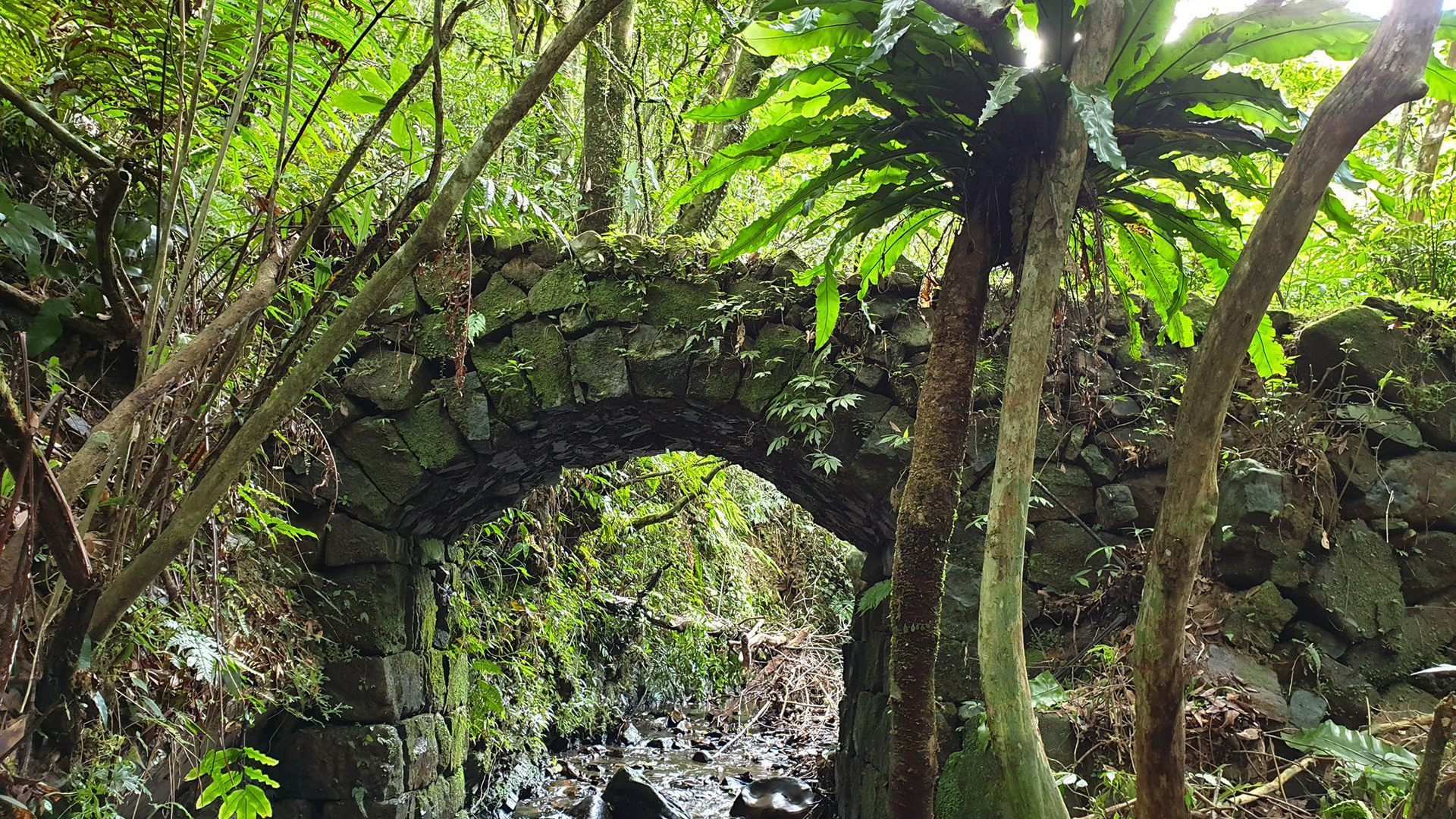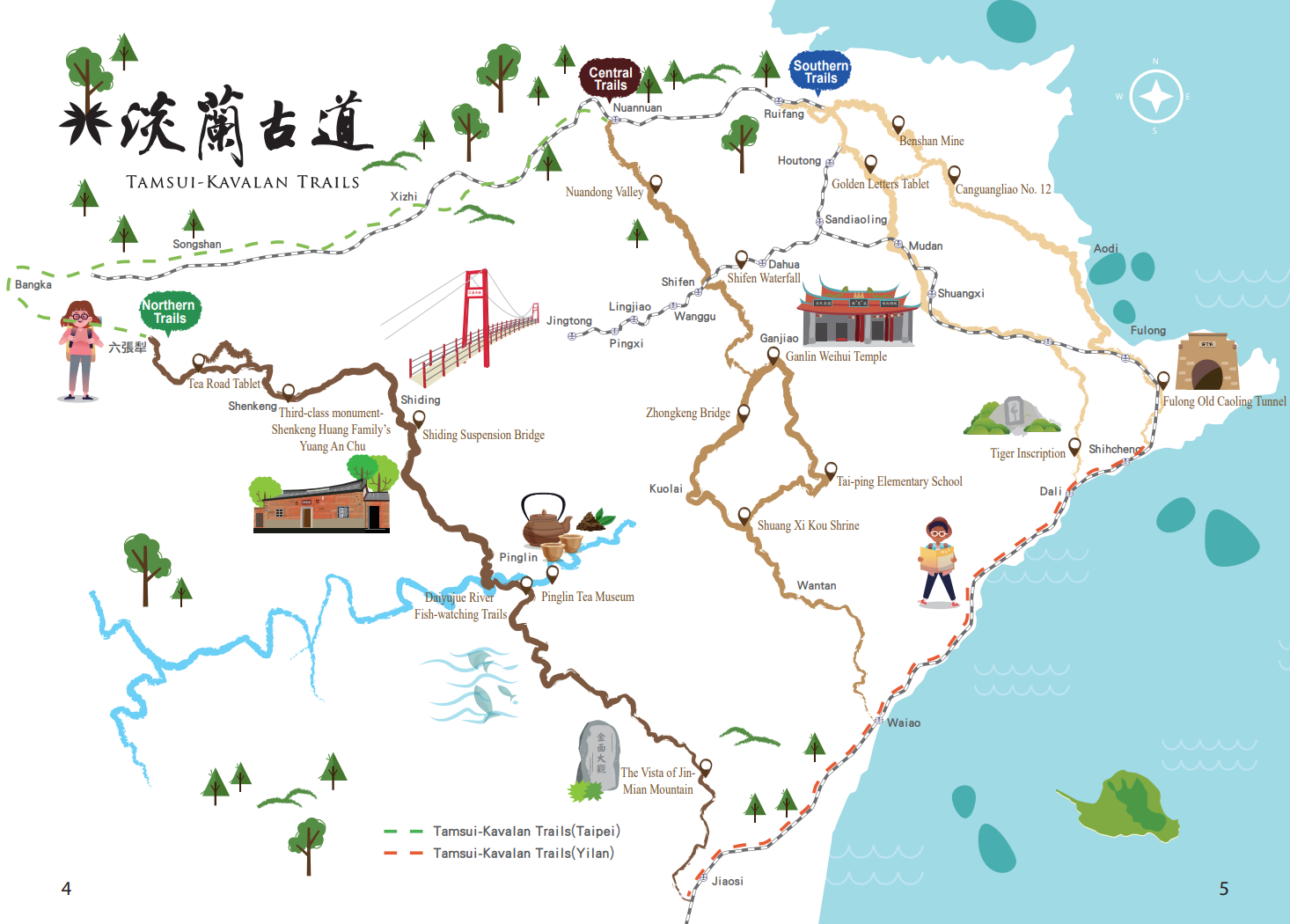
:::
Danlan Historic Trails that meander through Taipei City, New Taipei City, Keelung city, and Yilan County carry much history and memory about northern Taiwan. Take a walk along these century-old trails and you might feel you are in an open history class on Danlan in the mountains. These are the roads built by early Pingpu hunters, Han immigrants, armies, and tea merchants. The “baojia” paths which link up all villages in the region make a tight transport network. Today, a major path has even been adapted to be the Beiyi Highway. It can be said the roads are witnesses of the past.
The Northern Path (Officials’ Path)
The Northern Path is the oldest of the Danlan Old Trail System. In many historical documents, descriptions about the Northern Path can be found. It was first built for hunting and transport purposes for the common people, and with time, it became a path for warfare, inspection, and coastal patrol for the government. To ensure the safety of patrolling officers and to yield access to the general public again, more shortcuts were built later on, and these paths were soon utilized by travellers, merchants, settlers, and construction workers.
The Central Path (Civilians’ Path)
There are not as many official documents about the Central Path, since it was mostly used by ordinary people for everyday purposes. According to the existing documents, there used to be two subpaths, Lanrushan and Huanzong Daping, for early settlement, farming, and goods-transport purposes.
The Southern Path (Tea Transportation Path)
The Southern Path served as a tea transportation path during the Qing Dynasty. It was constructed by early tea farmers for transporting their tea, as the ruling Qing emperor failed to build a sub-path for them. The farmers then made use of rivers and small private paths to transport their goods alone. Fengzilin of Shiding and Shenkeng were the main ports. Along Jingmei, Xindian and Tamsui Rivers, the goods could finally arrive at Dadaocheng. The small private paths were built up and down hills and mountains, passing through Pinglinwei, Shiding, Shenkeng, and Liuzhangli. In 1860, international port trade began in Taiwan, and tea became the most important export goods. Most of the tea came from northern Taiwan. Driven by the growing tea trade, the emperor entrusted governor Liu Ming-chuan to officially build the Southern Path along the small paths in 1885, which leads to Yilan.

Download Map of Danlan Historic Trails
A journey into Danlan’s past
1723: Establishing the Tamsui District
In 1721, Jhu, Yi-Guei called for an uprising "to fight the Qing Dynasty and restore the Ming Dynasty" and after capturing Taiwan prefecture established himself as king. The Qing court believed that the original administrative division of "one capital and three counties" was no longer sufficient to meet the needs of governance and so it was expanded into "one capital, four counties and two halls" - adding "Changhua County" and "Tamsui Subprefecture ". The name “Tamsui” suggests that the district began with “Danlan” - development was taking place northward from the south.
1788: Initial development of the Southern Path
Due to the Lin Shuang-wen Rebellion, it was advised that a sub-path must be built. However, the idea didn’t come true for lack of funding.
1795: Mr. Bailan built the Northern and the Central Paths
There are two main path built by indigenous Pingpu hunters: (The Northern Path) Nuannuan - Sandiaoling: Nuannuan - Dingnei - Fengzilai - Jieyukeng - Qieshi (Shushi) - below Sandiaoling - Sanzhuazikeng - Zhuzitan - Sandiaoling. (Central Path) Nuannuan - Dingshuangxi: Nuannuan - Shifenliao - Fengziling - Dingshuangxi. It is believed that a man with the family name of Bailan was the founder of the Danlan transport system.
1796: Wu Sha cultivates the Yilan Plains
Wu Sha did business with and sold aboriginal products in Kavalan (now Yilan) for many years. At the time, many people from Zhangzhou and Quanzhou moved to Taiwan and Wu Sha realized that Kavalan was a perfect place for them to settle, so he planned to lead the Han Chinese in their cultivation of the land. The leader of the aboriginal village trusted Wu Sha and so allowed them to cultivate the land, but as more and more Han Chinese arrived so the area of cultivation increased. As a result, the indigenous peoples began to resist and armed conflict became more common. Later, Wu Sha signed agreements to ban cultivation without prior permission and successfully developed the Yilan Plain.
1807: Yang Ting-li resolved a riot
Pirates were rampant along the coasts of northern Taiwan. Prefectural magistrate Yang Ting-li came to Taiwan to suppress riots, and set up communication offices to enhance defense work. Villages and sub-roads were built around the offices later on. The main road is now called Yang Ting-li Historic Trail.
1810: The origin of the Southern Path (Tea Transportation Path)
Ching Lien-hou, a man from Quanzhou, Fujian Province in China, brought tea seedlings to Taiwan and grew them in Shenkeng. His tea plantation gradually extended to Shiding.
1812: Establishing the Kavalan District
After magistrate Yang Ting-li resolved the riot, he suggested that the Qing Empire establish the Kavalan District to facilitate administration in Taiwan. Since then, Kavalan had been under the Qing Empire’s reign. And because deliveries of governmental documents were needed between Tamsui and Kavalan Districts, the government decided to set up stations similar to today’s post office. As a result, the Northern Path was developed and crowds gathered up.
1824: Huang Ting-tai led people to log camphor in the mountains
Huang and his followers traveled to Wushan and Xiweiliao from Wai’ao, and found out that the area was open and flat. They recruited workers to go into the mountains with them to create farming zones and build an irrigation system. Today, this part of the history is called “leader Huang settled down in Daping.”Camphor was harvested from hilly land, with rice and sweet potatoes grown on the plains in the river valley, becoming an important source of income for local residents and attracting more Han Chinese to settle and gradually establish settlements.
1850: Armed Fights between Zhangzhou people and Quanzhou people
Most of the early Han immigrants in Taiwan were from Zhangzhou and Quanzhou in China. For long years, they fought against each other for land and water. The rivalry reached a peak in 1850 and only slowly subsided after 1860. The Central Path (Civilian’s Path) bears witness to the process of settlement, fight, and reconciliation.
1860: Opening up ports for commercial purposes in Taiwan
Defeated in the Second Opium War, the Qing Empire agreed to open up Tamsui and Keelung ports for commercial purposes. At this time, camphor, tea, and rice were the main exported goods in Taiwan. Camphor and tea were mostly from northern Taiwan, and therefore the region became much more prosperous. The Tea Transportation Path played an important role in the Danlan road system.
1867: Liu Ming-deng and Historic Sites of Sandiaoling and Caoling
General Liu Ming-deng inspected Kavalan and left a monument with golden writings in Sandiaoling, as well as two others that say “conquering savage land” and “tiger” in Caoling. These monuments bear witness to the development of “officials’ paths.”Today, these stone tablets are listed as national historic monuments but they are also famous historical relics on the Danlan Old Trails.
1872: Dr. George Leslie Mackay came to Taiwan to do missionary work
Dr. Mackay arrived in Taiwan in 1872 and he first did missionary work along Tamsui, Xindian, and Keelung Rivers. Later, he spread the gospel in Yilan and Su’ao. The things he left behind became important historical documents for learning about Danlan and its paths.
1885: Provincial governor Liu Ming-chuan develops Danlan trail
Recognizing the importance of Taiwan the Qing court designated it a province in 1885, appointing Liu Ming-chuan as the first governor. After assuming his new position Liu actively promoted many modernization and construction projects. For a hundred years, many people grew tea in the mountains. With time, tea became the most profitable economic crop in Taiwan, and the Southern Path became truly busy. The government thus built a sub-path to Kavalan, following the Tea Transportation Path. Upon expansion, it became the Beiyi Highway today.